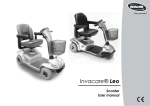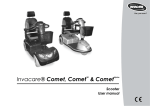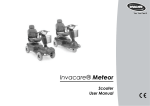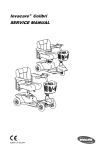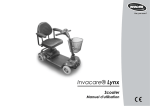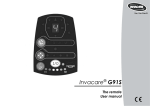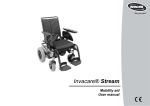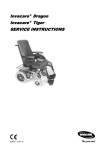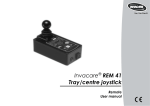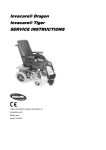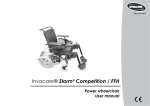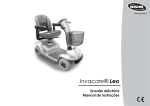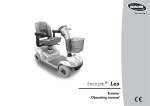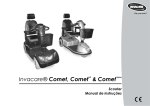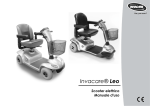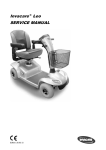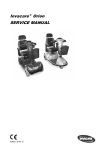Download Lynx User Manual
Transcript
Yes, you can.® Invacare® Lynx Scooter User manual 2 How can you get in touch with Invacare®? If you have any questions or need support, please contact your authorised Invacare® Dealer, who has the necessary know-how and equipment plus the special knowledge concerning your Invacare® product, and can offer you all-round satisfactory service. Should you wish to contact Invacare® directly, you can reach us in Europe at the following addresses and phone numbers. Invacare Austria GmbH Herzog Odilostrasse 101 A-5310 Mondsee Austria : Fax: @: WWW: +43 6232 5 53 50 +43 6232 5 53 54 [email protected] www.invacare.at Invacare n.v. Autobaan 22 B-8210 Loppem (Brugge) Belgium : Fax: @: WWW: +32 (0)50 83 10 10 +32 (0)50 83 10 11 [email protected] www.invacare.be Invacare AG Benkenstraße 260 CH-4108 Witterswil Switzerland : Fax: @: WWW: +41 (0)61487 70 80 +41 (0)61487 70 81 [email protected] www.invacare.ch Invacare GmbH Alemannenstraße 10 88316 Isny Deutschland Fax @: WWW: +49 (0)7562 70 00 +49 (0)7562 7 00 66 [email protected] www.invacare.de Invacare A/S Sdr. Ringvej 37 DK-2605 Brøndby Danmark (Kundeservice): Fax (Kundeservice): @: WWW: Invacare® SA c/ Areny s/n Polígon Industrial de Celrà E-17460 Celrà (Girona) ESPAÑA : Fax: @: WWW: +45 (0)36 90 00 00 +45 (0)36 90 00 01 [email protected] www.invacare.dk +34 (0)972 49 32 00 +34 (0)972 49 32 20 [email protected] www.invacare.es 3 Invacare® Poirier SAS Route de St Roch F-37230 Fondettes France : Fax: @: WWW: Invacare® Ltd Pencoed Technology Park Pencoed Bridgend CF35 5AQ United Kingdom (Customer services): Fax (Customer services): @: WWW: Invacare Mecc San s.r.l. Via dei Pini, 62 I - 36016 Thiene (VI) ITALIA : Fax: @: WWW: +39 0445 38 00 59 +39 0445 38 00 34 [email protected] www.invacare.it Invacare Ireland Ltd. Unit 5 Seatown Business Campus Seatown Rd, Swords County Dublin Ireland : Fax: @: WWW: +353 18 10 70 84 +353 18 10 70 85 [email protected] www.invacare.ie Invacare® AS Grensesvingen 9 Postboks 6230 Etterstad N-0603 Oslo Norge (Kundeservice): Fax (Kundeservice): @: @: WWW: +47 (0)22 57 95 00 +47 (0)22 57 95 01 [email protected] [email protected] www.invacare.no Invacare® B.V. Celsiusstraat 46 NL-6716 BZ Ede Nederland : Fax: @: @: WWW: +31 (0)318 69 57 57 +31 (0)318 69 57 58 [email protected] [email protected] www.invacare.nl : : Fax: @: WWW: +351 225 10 59 46 +351 225 10 59 47 +351 225 10 57 39 [email protected] www.invacare.pt Invacare Lda Rua Estrada Velha, 949 P-4465-784 Leça do Balio Portugal 4 +33 (0)247 62 64 66 +33 (0)247 42 12 24 [email protected] www.invacare.fr +44 (0)1656 77 62 22 +44 (0)1656 77 62 20 [email protected] www.invacare.co.uk Återförsäljare: Invacare® AB Fagerstagatan 9 S-163 91 Spånga Sverige (Kundtjänst): Fax (Kundtjänst): @: @: WWW: Tillverkare: Invacare® Deutschland GmbH Kleiststraße 49 D-32457 Porta Westfalica Deutschland MÖLNDAL : Fax: @: Eastern european countries European Distributor Organisation (EDO) Kleiststraße 49 D-32457 Porta Westfalica Deutschland +46 (0)8 761 70 90 +46 (0)8 761 81 08 [email protected] [email protected] www.invacare.se +46 (0)31 86 36 00 +46 (0)31 86 36 06 [email protected] LANDSKRONA : Fax: @: +46 (0)418 2 85 40 +46 (0)418 1 80 89 [email protected] OSKARSHAMN : Fax: @: +46 (0)491 1 01 40 +46 (0)491 1 01 80 [email protected] Fax @: WWW: +49 (0)5731 75 45 40 +49 (0)5731 75 45 41 [email protected] www.invacare.de 5 Table of Contents Chapter 1 Introduction 1.1 1.2 1.3 1.4 1.5 2 6 6 21 22 24 Before driving for the first time..............................................................................................24 Taking Obstacles.....................................................................................................................25 Driving up and down gradients..............................................................................................26 Parking and stationary............................................................................................................26 Pushing the scooter by hand 6.1 14 General safety notes ...............................................................................................................14 Safety information with regard to care and maintenance ...................................................17 Safety information on electromagnetic interference ...........................................................18 Safety information on driving and freewheel mode.............................................................19 Key features The position of the labels on the product Driving 5.1 5.2 5.3 5.4 9 Important symbols in this manual .........................................................................................10 Important symbols found on the vehicle ..............................................................................12 Type classification and permissible use...............................................................................12 Warranty ...................................................................................................................................13 Life expectancy........................................................................................................................13 Safety notes 2.1 2.2 2.3 2.4 3 4 5 Page 27 Disengaging Motors ................................................................................................................27 7 Operating console 7.1 7.2 7.3 7.4 8 9 Operating console arrangement ............................................................................................28 7.1.1 Status display ...............................................................................................................29 7.1.2 Battery charge display ..................................................................................................29 Driving the Scooter .................................................................................................................30 Diagnosis and fault repair .....................................................................................................32 7.3.1 Error diagnosis..............................................................................................................33 Error Codes and Diagnostic Codes.......................................................................................34 Adjustment facilities 8.1 8.2 8.3 9.2 51 Cleaning the mobility device ..................................................................................................51 Inspection checks ...................................................................................................................52 11 Dismantling the Scooter for transport 11.1 41 Electronics protection system ...............................................................................................41 9.1.1 The main fuse ...............................................................................................................42 Batteries ...................................................................................................................................42 9.2.1 What you need to know about batteries .......................................................................42 9.2.2 Charging the batteries ..................................................................................................44 9.2.3 Removing and fitting batteries ......................................................................................46 9.2.3.1 Removing the batteries............................................................................................47 9.2.3.2 How to handle damaged batteries correctly ............................................................50 10 Care and maintenance 10.1 10.2 37 Adjusting the armrest width ...................................................................................................37 Disengaging the seat to rotate it or remove it ......................................................................38 Adjusting the seat height........................................................................................................39 Electrical system 9.1 28 53 Removing the seat...................................................................................................................53 7 11.2 Removing the battery and drive unit .....................................................................................54 11.2.1 Removing the batteries.................................................................................................54 11.2.2 Removing the drive unit ................................................................................................54 12 Disposal 13 Technical specifications 14 Inspections Performed 8 55 56 59 1 Introduction Dear user, First we would like to thank you for purchasing our product! We hope you will enjoy your new Scooter. This manual contains important hints and information on: • Safety • Operation • Care and maintenance. Please take care to read the operating manual thoroughly before starting out on your first journey. This product has been designed to fit the needs of different types of users with different requirements. The decision whether the model is suitable for the user may only be taken by medical specialists with appropriate aptitude. Invacare® or their statutory representatives can accept no liability in cases in which the mobility product has not been adapted to suit the user's handicaps. Some maintenance and settings can be carried out by the user. Certain adjustments do however require technical training and may only be carried out by your Invacare® specialist dealer. Damages and errors caused by nonobservance of the operating manual or as a result of incorrect maintenance are excluded from all guarantees. 9 This manual contains copyrighted information. It may not be reproduced or copied in whole or in part without the prior written consent of Invacare® or its authorised representative. It may also contain information that pertains to models sold only in certain countries. In this case the information will be clearly marked as pertaining to a particular country-specific version. We reserve the right to make any alterations on the grounds of technical improvements. 1.1 Important symbols in this manual General risks This symbol warns you of general hazards! • Always follow the instructions to avoid injury to the user or damage to the product. EXPLOSION HAZARD! This symbol warns you of an explosion hazard, which can be caused by excessive tyre pressure in a pneumatic tyre. • Always follow the instructions to avoid injury to the user or damage to the product. BURN HAZARD! This symbol warns you of the danger of chemical burns, for example due to the discharge of battery acids! • Always follow the instructions to avoid injury to the user or damage to the product. BURN Risk! This symbol warns of the risk of burns, for example, as a result of hot motor surfaces. • Follow the instructions in order to avoid injury or damage to the product. 10 RISK OF CRUSHING! This symbol warns of a risk of crushing caused by being careless with heavy components. • Always follow the instructions to avoid injury to the user or damage to the product. Wear eye protection This symbol refers to the requirement for wearing eye protection, for example when working with batteries. • You must wear safety goggles when this symbol is displayed. Wear protective gloves This symbol indicates the requirement to wear protective gloves, for example when working with batteries. You must wear protective gloves when this symbol is displayed. NOTE: This symbol identifies general information which is intended to simplify working with your product and which refers to special functions. Requirements: • This symbol identifies a list of various tools, components and items which you will need in order to carry out certain work. Please do not attempt to carry out the work if you do not have the listed tools available. READ WELL BEFORE OPERATION! This symbol advises you to read information carefully. 11 1.2 Important symbols found on the vehicle This product has been supplied from an environmentally aware manufacturer. This product may contain substances that could be harmful to the environment if disposed of in places (landfills) that are not appropriate according to legislation. • The 'crossed out wheelie bin' symbol is placed on this product to encourage you to recycle wherever possible. • Please be environmentally responsible and recycle this product through your recycling facility at its end of life. 1.3 Type classification and permissible use This vehicle was designed for persons whose ability to walk is impaired, but who are still in terms of their eyesight and physically and mentally able to operate an electric vehicle. It has been classified according to EN 12184 as a class A mobility product (internal use). You can find precise information about speeds, turning radius, driving range, maximum safe slope, maximum obstacle height and permissible operating conditions in chapter "Technical specifications" on page 56. Please also pay attention to all safety information in chapter "Safety notes" from page 14. The vehicle was successfully tested according to German and international standards as to its safety. It satisfies the requirements according to DIN EN 12184 including EN 1021-1/-2. It was also tested successfully according to EN60529 IPX4 as to its resistance to spray water, and is therefore well suited for typical middle European weather conditions. 12 1.4 Warranty The terms and conditions of the warranty are part of the general terms and conditions particular to the individual countries in which this product is sold. 1.5 Life expectancy We estimate a life expectancy of five years for this product, provided it is used in strict accordance with the intended use as set out in this document and all maintenance and service requirements are met. The estimated life expectancy can be exceeded if the product is carefully used and properly maintained, and provided technical and scientific advances do not result in technical limitations. The life expectancy can also be considerably reduced by extreme or incorrect usage. The fact that we estimate a life expectancy for this product does not constitute an additional warranty. 13 2 Safety notes READ WELL BEFORE OPERATION! 2.1 General safety notes Danger of injury if this scooter is used in any other way than the purpose described in this manual! • Adhere strictly to the instructions in this user manual! Danger of injury if the scooter is driven when your ability to drive is impaired by medication or alcohol! • Never drive any vehicle under the influence of medication or alcohol! Danger of damage or injury if the scooter is accidentally set into motion! • Switch the power system off before you get in, get out or handle awkward objects! • Be aware that the motor brakes are automatically deactivated when the motors are disengaged. For this reason, freewheel operation is only recommended on flat surfaces, never on gradients. Never leave your vehicle on a gradient with its motors disengaged. Always reengage the motors immediately after pushing the vehicle. 14 Danger of injury if the On/Off Button is pressed while the vehicle is in motion, due to it coming to an abrupt, sharp stop! • If you have to brake in an emergency, simply pull the handbrake until the scooter comes to a halt! Only switch the vehicle off while in motion as a last resort! Danger of injury if the scooter is transported in another vehicle with the occupant seated in it! • Never transport the scooter with the occupant seated in it! Danger of injury if maximum permissible load is exceeded! • Do not exceed the maximum permissible load (see "Technical specifications" on page 56)! Danger of injury when lifting heavy components! • When maintaining, servicing or lifting any part of your scooter, take into account the weight of the individual components, especially the batteries! Be sure at all times to adopt the correct lifting posture and ask for assistance if necessary! Danger of injury if you fall off the scooter! • If restraining systems are installed (such as seat belts), use them each time you drive the scooter. 15 Danger of injury by moving parts! • Make sure that no injury is incurred by moving parts of the scooter, like wheels or a Seat Lifter, especially when children are around! Risk of injury from hot surfaces! • Do not leave the mobility device in direct sunlight for prolonged periods. Metal parts and surfaces such as the seat and armrests can become very hot. Danger of fire or breaking down due to electric devices being connected! • Do not connect any electric devices to your vehicle that are not expressly certified by Invacare® for this purpose! Have all electrical installations done by your authorised Invacare® Dealer! Danger of technical failure and injury if unauthorised spare parts and components are used! • Only use original Invacare® spare parts, which have been approved for use with this vehicle! 16 2.2 Safety information with regard to care and maintenance Danger of accident and loss of guarantee if maintenance is insufficient! • For reasons of safety and in order to avoid accidents which result from unnoticed wear, it is important that this electric mobility product undergoes an inspection once every year under normal operating conditions (see inspection plan contained in service instructions). • Under difficult operating conditions such as daily travel on steep slopes, or in the case of use in medical care cases with frequently changing wheelchair users, it would be expedient to carry out intermediate checks on the brakes, accessories and running gear. • If the mobility product is to be operated on public roads, the vehicle driver is responsible for ensuring that it is in an operationally reliable condition. Inadequate or neglected care and maintenance of the mobility product will result in a limitation of the manufacturer's liability. 17 2.3 Safety information on electromagnetic interference This electric vehicle was successfully tested in accordance with International standards as to its compliance with Electromagnetic Interference (EMI) regulations. However, electromagnetic fields, such as those generated by radio and television transmitters, and cellular phones can influence the functions of electric vehicles. Also, the electronics used in our vehicles can generate a low level of electromagnetic interference, which however will remain within the tolerance permitted by law. For these reasons we ask you to please observe the following precautions: WARNING: Danger of malfunction due to electromagnetic interference! • Do not switch on or operate portable transceivers or communication devices (such as radio transceivers or cellular phones) when the vehicle is switched on. • Avoid getting near strong radio and television transmitters. • In case the vehicle should be set in motion unintentionally or the brakes are released, switch it off immediately. • Adding electrical accessories and other components or modifying the vehicle in any way can make it susceptible to electromagnetic interference. Keep in mind that there is no sure way to determine the effect such modifications will have on the overall immunity of the electronic system. • Report all occurrences of unintentional movement of the vehicle, or release of the electric brakes to the manufacturer. 18 2.4 Safety information on driving and freewheel mode Danger of injury if the vehicle tips over! • Only ever negotiate gradients up to the maximum tilt-resistant gradient and only with the backrest in an upright position, and the seat lifter in the lowest position (if installed)! • Only ever drive downhill at a maximum of 2/3rds of the top speed! Avoid abrupt braking or accelerating on gradients! • If at all possible, avoid driving on slippery surfaces (such as snow, gravel, ice etc.) where there is a danger of you losing control over the vehicle, especially on a gradient! If driving on such a surface is inevitable, then always drive slowly and with the utmost caution! • Never attempt to overcome an obstacle when on an uphill or downhill gradient! • Never attempt to drive up or down a flight of steps! • Always approach obstacles straight on! Ensure that the front wheels and rear wheels move over the obstacle in one stroke, do not stop halfway! Do not exceed the maximum obstacle height (see "Technical specifications" on page 56)! • Avoid shifting your centre of gravity as well as abrupt changes of direction when the vehicle is in motion! 19 Danger of injury if the vehicle tips over! (Continued) • Never use the vehicle to transport more than one person! • Do not exceed the maximum permissible load! • When loading the vehicle, always distribute the weight evenly! Always try to keep the centre of gravity of the vehicle in the middle, and as close to the ground as possible! • Note that the vehicle will brake or accelerate if you change the Driving Speed while it is in motion! Danger of injury if you collide with an obstacle when driving through narrow passages such as doorways and entrances! • Drive through narrow passages in the lowest Driving Speed and with due caution! CAUTION: The centre of gravity for the scooter is higher than that of an electric wheelchair! There is an increased tipping hazard when negotiating bends! • Reduce speed before negotiating bends! Only accelerate when you have come out of the bend! CAUTION: Danger of tipping! Anti tip wheels (stabilisers) are only effective on firm ground! They sink in on soft ground such as grass, snow or mud if the mobility device rests itself on them. They lose their effect and the mobility device can tip over. • Only drive with extreme care on soft ground, especially during uphill and downhill journeys. In the process pay increased attention to the tip stability of the mobility device. 20 3 Key features 1) Disengaging lever 2) Unlocking lever for swivelling and removing seat (left below seat) 3) Operating console 4) Lever for adjusting steering column inclination 21 4 The position of the labels on the product 1) Voltage warning sign label Battery label under the cover 22 2) Identification label sticker on the seat support tube 3) Manufacturer label on the seat support tube 4) Distributor label on the chassis at the rear 5) Drive unit warning sign label The symbols on the labels are explained in section "Important symbols found on the vehicle" on page 12. 23 5 Driving 5.1 Before driving for the first time... Before you take your first trip, you should familiarise yourself well with the operation of the vehicle and with all operating elements. Take your time to test all functions and driving modes. NOTE: If installed, make sure to properly adjust and use the postural belt each time you use the wheelchair. Sitting Comfortably = Driving Safely Before each trip, make sure that: 24 • You are within easy reach of all operating controls. • The battery charge is sufficient for the distance intended to be covered. • The postural belt (if installed) is in perfect order. • The rear mirror (if installed) is adjusted so you can look behind at all times without having to bend forward or shift your seating position. 5.2 Taking Obstacles Your Scooter can climb obstacles and kerbs of up to 3 cm in height. CAUTION: Danger of Tipping Over! • Never approach obstacles at an angle but at 90 degrees as shown below. • Put your backrest into an upright position before climbing an obstacle. Driving up over an obstacle • Correct Approach the kerb or obstacle slowly head-on. Shortly before the front wheels touch the obstacle, increase the speed and reduce only after the rear wheels have also climbed the obstacle. Driving down off of an obstacle • Approach the kerb or obstacle slowly head-on. Before the front wheels touch the obstacle, reduce speed and keep it until also the rear wheels have come down off of the obstacle. Incorrect 25 5.3 Driving up and down gradients For information concerning the maximum safe slope, please see chapter "Technical specifications" starting on page 56. WARNING: Danger of tipping over! • Only ever drive downhill at a maximum of 2/3rds of the top speed! • Always return the backrest of your seat to an upright position before ascending slopes! We recommend that you lean the backrest slightly to the rear before descending slopes! • Never attempt to ascend or descend a slope on slippery surfaces or where there is a danger of skidding (such as wet pavement, ice etc)! • Avoid trying to get out of the vehicle on an incline or a gradient! • Always drive in a straight direction along the road or path you are travelling on, rather than attempting to zigzag! • Never attempt to turn around on an incline or a slope! 5.4 Parking and stationary If you park your vehicle, or leave it at a standstill for a longer period: • 26 switch off the power supply (keyswitch). 6 Pushing the scooter by hand The motors of the scooter are equipped with automatic brakes, preventing the scooter from rolling away out of control when the power supply is switched off. When pushing the scooter, the magnetic brakes must be disengaged. 6.1 Disengaging Motors Danger of the vehicle running away! • When the motors are disengaged (for push operation whilst freewheeling), the electromagnetic motor brakes are deactivated! When the vehicle is parked, the levers for engaging and disengaging the motors must without fail be locked firmly into the "DRIVE" position (electromagnetic motor brakes activated)! The lever for engaging and disengaging the motor is located on the right-hand side at the rear. Disengaging the drive • Switch off the Scooter (keyswitch). • Push the disengaging lever forwards. The drive is now disengaged. Engaging the drive • Pull the lever to the rear. 27 7 Operating console 7.1 Operating console arrangement 28 1) Battery charge display 2) Horn 3) Status display 4) Keyswitch (ON/OFF) 5) Speed controller 6) Drive lever 7.1.1 Status display NOTE: The ON/OFF diode is used as a fault display (status display). Chapter "Error Codes and Diagnostic Codes" on page 34 contains an explanation of the error codes. 7.1.2 Battery charge display • • • Pointer in green area: maximum driving range Pointer in yellow area: reduced driving range. Recharge the batteries at the end of your journey. Pointer in red area: battery reserve = severely restricted driving range. Recharge batteries immediately! NOTE: Overdischarge protection: after a certain drive time on reserve battery power the electronics system switches the drive off automatically and brings the Scooter to a standstill. If you do not drive your Scooter for a while the batteries will "recuperate" and allow a further, but short, journey. However, after a very brief journey the red diodes will illuminate again and the electronic system will beep three times. This procedure leads to battery damage and should be avoided if possible! 29 7.2 Driving the Scooter WARNING: Danger from the unintended rolling of the vehicle! When stopping the vehicle, the drive lever needs to return entirely to the middle position to activate the electromagnetic brakes. If there is any obstruction stopping the lever from returning to the middle position, the electromagnetic brakes cannot be activated. This can lead to the vehicle rolling unintentionally. • Please make sure that the drive lever is in the middle position, if the vehicle is to remain stationary. • Switch the power supply on (keyswitch) The operating console display illuminates. The Scooter is ready to drive. NOTE: If the Scooter is not ready to drive after switching on, check the status display (see Chapter "Status display" on page 29 and Chapter "Diagnosis and fault repair" on page 32. • Set the required speed with the speed controller. • Pull the right-hand drive lever carefully to travel forwards. • Pull the left-hand drive lever carefully to travel in reverse. NOTE: The control system is programmed with standard values in the works. Your Invacare®dealer can carry out programming tailored to fit your requirements. 30 Caution: any changes to the drive program can affect the driving characteristics and the tipping stability of the vehicle! • Changes to the drive program may only be carried out by trained Invacare® specialist dealers! • Invacare® supplies all mobility products with a standard drive program ex-works. Invacare® can only give a warranty for safe vehicle driving behaviour - especially the tipping stability for this standard drive program! NOTE: To brake quickly, simply let go of the drive lever. It will then automatically return to the middle position. The Scooter will brake. 31 7.3 Diagnosis and fault repair The electronic system offers diagnostic information to support the technician during the recognition and rectification of faults on the Scooter. If there is a fault, the status display blinks several times, pauses, then blinks again. The type of fault is displayed by the number of blinks in each group, which are also known as the "blink code". The electronic system reacts differently depending on the seriousness of the fault and its effect on user safety. It can, for example: • simply show the blink code as a warning and allow both driving and normal operation to continue; • display the blink code, stop the Scooter and prevent further travel until the electronic system has been switched off and switched on again; • display the blink code, stop the Scooter and not permit further travel until the fault has been rectified. You can find detailed descriptions of individual blink codes, including possible causes and fault repair, in the section entitled "Error Codes and Diagnostic Codes" on page 34. 32 7.3.1 Error diagnosis If the Scooter shows a failure, please use the following guide to locate the fault. NOTE: Before making any diagnosis, ensure that the Scooter has been switched on at the keyswitch. If the status display is OFF: check whether the keyswitch is SWITCHED ON. Check whether all cables are correctly connected. If the status bar indicator is BLINKING: count the number of blinks and then proceed to the next section. 33 7.4 Error Codes and Diagnostic Codes Blink code 1 2 3 FAULT Consequence for the Scooter Battery must be Continues to • charged drive Battery voltage too Stops driving • low • Battery voltage too Stops driving high • • 34 Comments The batteries are discharged. Charge the battery as soon as possible. The batteries are depleted. Charge batteries. If you switch the Scooter off for a few minutes, the battery can often recuperate to such a stage that a short journey is still possible. You should only do this in emergency, however, because this causes the batteries to become excessively discharged! The battery voltage is too high. If the battery charger is connected, disconnect it from the Scooter. The electronic system charges the batteries when running downhill and when braking. This fault is caused when the battery voltage becomes too high during this process. Switch the Scooter off and on again. Switch on the lights to use up some power. Blink code 4 FAULT Power time exceeded Consequence for the Scooter Stops driving • • 5 Brake failure Stops driving • • 6 No neutral position Stops driving when switching Scooter on. • • 7 Fault in speed potentiometer Stops driving • Comments The Scooter has used up too much power for a long period, probably because the motor has been overloaded or the Scooter has attempted to work against insurmountable resistance. Switch off the Scooter, wait a few minutes and then switch it on again. The electronic system has determined a motor short-circuit. Check the wiring harness for short-circuits and check the motor: Contact your Invacare® dealer. Ensure that the disengaging lever is in the engaged position. There is a defect in the braking coil or in the cabling. Check the wheel lock and cabling for open or short-circuited circuits. Contact your Invacare® dealer. Drive lever is not in neutral when the keyswitch was turned. Put the drive lever in neutral, turn the power off and then turn on again. It may be necessary to recalibrate the drive lever. Contact your Invacare® dealer. The drive lever electronics could be faulty or incorrectly connected. Contact your Invacare® dealer. 35 Blink code 8 9 10 36 FAULT Consequence for the Scooter Motor voltage error Stops driving • Miscellaneous internal fault Push mode / free running Stops driving • Continues to drive • Comments The motor or its cabling is defective Contact your Invacare® dealer. Contact your Invacare® dealer. The Scooter has exceeded the maximum speed for push mode / free running. Switch the electronics system off and on again. 8 Adjustment facilities 8.1 Adjusting the armrest width The hand wheels for releasing the armrests are located under the seat (1). • Turn the hand wheels to loosen the fixing for the armrest. • Adjust the armrests to the required width. • Retighten the handwheels 37 8.2 Disengaging the seat to rotate it or remove it The seat can be turned to one side to make getting in and out of the scooter easier. The seat is also easier to remove from this position. The lever for disengaging the seat is located under the seat (1) on the right. 38 • Pull the lever upwards to disengage the seat. • Turn the seat to one side. • If you want to remove the seat, hold it firmly by the backrest and front edge and remove it upwards. 8.3 Adjusting the seat height The seat height can be adjusted to 39, 41, , or 43 cm. Requirements: • 2x open-ended spanners 17 mm • Remove the seat • Remove the battery and motor compartment cover. • Withdraw the securing bolts (1) on the ring. • Loosen the handwheel (2). 39 40 • Adjust the seat height. • Replace the securing bolts. • Retighten the handwheel. 9 Electrical system 9.1 Electronics protection system The vehicle's electronics are equipped with an overload-protection system. If the motors are put under considerable strain for a longer period of time (for example, when driving up a steep hill) and especially when the ambient temperature is high, then the electronic system could overheat. In this case the vehicle's power is reduced gradually until it finally comes to a halt. The Status Display shows a corresponding error code (see chapter "Error Codes and Diagnostic Codes" on page 34). By switching the power supply off and back on again, the error code is cancelled and the electronics are switched back on. It will take approximately five minutes until the electronics have cooled down enough for the motors to restore full power again. When the motors are stalled by an insurmountable obstacle, such as a high kerb, and the vehicle driver allows the motors to strain against this hindrance for more than 20 seconds without moving, then the electronics will automatically switch off to prevent the motors from being damaged. The Status Display shows a corresponding error code (see chapter "Error Codes and Diagnostic Codes" on page 34). By switching off and back on again, the error code is cancelled and the electronics are switched back on. 41 9.1.1 The main fuse The entire electric system is protected against overload by two master fuses. The master fuses are mounted on the positive battery cables. NOTE A defective main fuse may be replaced only after checking the entire electric system. An Invacare® specialised dealer must perform the replacement. You can find information on the fuse type in chapter "Technical specifications" starting on page 56. 9.2 Batteries 9.2.1 What you need to know about batteries Power is supplied by two 12 V batteries. The batteries are maintenance-free and only need regular charging. New batteries should always be fully charged once before their first use. New batteries will be at their full capacity after having run through approx. 10 - 20 charging cycles. How fast the batteries discharge depends on many circumstances, such as ambient temperature, condition of the surface of the road, tyre pressure, weight of the driver, way of driving and utilisation of lighting. 42 NOTE The batteries supplied with your electric vehicle are not hazardous goods. This classification is based on the German GGVS Hazardous Goods Road Transport Ordinances, and the IATA/DGR Hazardous Goods Rail Transport / Air Transport Ordinances. Batteries may be transported without restrictions, whether by road, rail or by air. Individual transport companies have, however, guidelines which can possibly restrict or forbid certain transport procedures. Please ask the transport company regarding each individual case. Pay attention to the Battery Charge Indicator! Make sure to charge the batteries when the Battery Charge Indicator shows that battery charge is low. We recommend charging the batteries after each trip, as well as each night over night. Depending on the level of discharge, it can take up to 12 hours until the batteries are fully charged again. Protect your charger from sources of heat such as heaters and direct sunlight. If the battery charger overheats, charging current will be reduced and the charging process delayed. To avoid damaging the batteries, never allow them to be fully discharged. Do not drive on heavily discharged batteries if it is not absolutely necessary, as this will strain the batteries unduly and shorten their life expectancy. In case your vehicle is not used for a longer period of time, then the batteries must be charged at least once a month to maintain a full charge. Alternatively, the vehicle can stay connected to the charger. The batteries cannot be overcharged with the specified charger. Please use only charging devices in Class 2. This class of chargers may be left unattended during charging. All charging devices which are supplied by Invacare® comply with these requirements. 43 9.2.2 Charging the batteries WARNING! Risk of explosion and destruction of batteries if the wrong battery charger is used! • Only ever use the battery charger supplied with your vehicle, or a charger that has been approved by Invacare®. Risk of electric shock and damage to the battery charger if it gets wet! • Protect the battery charger from water. • Always charge in a dry environment. Risk of short circuit and electric shock if the battery charger has been damaged! • Do not use the battery charger if it has been dropped or damaged. Risk of electric shock and damage to the batteries! • NEVER attempt to recharge the batteries by attaching cables directly to the battery terminals. Risk of fire and electric shock if a damaged extension cable is used! • Only ever use an extension cable if it is absolutely necessary. In case you must use one, make sure it is in good condition. Risk of injury if using the wheelchair during charging! • DO NOT attempt to recharge the batteries and operate the wheelchair at the same time. • DO NOT sit in the wheelchair while charging the batteries. 44 The charging socket is located under the seat Connect the scooter to the mains supply to charge • Switch off the Scooter. • Fold up the charging socket protective cap. • Connect the mains cable to the scooter. • Connect the mains cable to the power supply. Disconnecting the scooter from the power supply • Disconnect the mains cable from the power supply. • Disconnect the mains cable from the Scooter. 45 9.2.3 Removing and fitting batteries WARNING: Danger of injury if the batteries are not handled correctly during assembly and maintenance work! • New batteries should be installed by authorised technicians! • Observe the warnings on the batteries! • Take into account the heavy weight of the batteries! • Only ever use the battery type defined in the technical specifications (see "Technical specifications" on page 56)! Danger of fire and burns if battery terminals are short-circuited! • DO NOT short-circuit battery terminals with a tool! WARNING: Corrosion and burns from acid leakage if batteries are damaged! • Remove clothes that have been soiled by acid immediately. After contact with skin: • Immediately wash affected area with lots of water. After contact with eyes: • Immediately rinse eyes under running water for several minutes; consult a physician. 46 9.2.3.1 Removing the batteries Requirements: • Phillips screwdriver • Remove the seat. • Remove the battery and motor compartment cover. • Remove the battery pack. • Turn the battery pack round. • The position of the retaining bolts is shown in figure on the right. • Unscrew the bolts. 47 48 • The battery pack can now be opened. • Remove the connecting plugs on the battery terminal. • The batteries are held by clips which are fixed by screws. Remove the screws and pull the clips out to the side. • The batteries can now be removed and replaced. NOTE: Replacing new batteries takes place in reverse order. 49 9.2.3.2 How to handle damaged batteries correctly WARNING: Corrosion and burns from acid leakage if batteries are damaged! • Remove clothes that have been soiled by acid immediately. After contact with skin: • Immediately wash affected area with lots of water. After contact with eyes: • Immediately rinse eyes under running water for several minutes; consult a physician. • Always wear safety goggles and appropriate safety clothing when handling damaged batteries. • Place damaged batteries in an acid-resistant receptacle immediately after removing them. • Only ever transport damaged batteries in an appropriate acid-resistant receptacle. • Wash all objects that have come into contact with acid with lots of water. Disposing of dead or damaged batteries correctly Dead or damaged batteries can be given back to your dealer or directly to Invacare®. 50 10 Care and maintenance The term „Maintenance“ means any task performed to ensure that a medical device is in good working order and ready for use as intended. Maintenance encompasses different areas, such as everyday care and cleaning, inspection checks, repair tasks and refurbishment. NOTE: Have your vehicle checked once a year by an authorised Invacare® dealer in order to maintain it's driving safety and roadworthiness. 10.1 Cleaning the mobility device When cleaning the mobility device, pay attention to the following points: • Only use a damp cloth and gentle detergent. • Do not use any abrasive or scouring agents. • Do not subject the electronic components to any direct contact with water. • Do not use any high-pressure cleaning devices. Disinfection Spray or wipe disinfection using a tested and recognised product is permitted. A list of the current permitted disinfectants is available from the Robert Koch Institute at http://www.rki.de. 51 10.2 Inspection checks Horn: Check function Please contact your dealer in case of failure. Tyres: Check for foreign bodies (glass splinters, nails) and damage. Replace outer tyre if necessary. Batteries / electrical system Check battery charging status. Charge batteries if necessary (see "Charging the batteries" on page 44) Checked all connecting plugs for condition and stable connections. Press connecting plugs firmly together if necessary. Wheel lock (if fitted): Check wheel lock function. Please contact your dealer if the brake is defective. 52 Monthly Weekly Inspection work (to be carried out by user) Before each journey The following table lists inspection checks that should be performed by the user and their intervals. If the mobility device fails to pass one of the inspection checks, please refer to the chapter indicated or contact your authorised Invacare® dealer. A more comprehensive list of inspection checks and instructions for maintenance work can be found in the Service Manual for this device, which can be obtained from Invacare®. That Manual, however, is intended to be used by trained and authorised service technicians, and describes tasks which are not intended to be performed by the user. 11 Dismantling the Scooter for transport Please proceed as follows to dismantle the Scooter for transport: • Remove the seat • Take out batteries • Remove the drive unit Please proceed in reverse order to reassemble the Scooter. 11.1 Removing the seat The lever for releasing the seat so that the seat can be rotated and removed is located on the left under the seat (1). • Pull the lever upwards to disengage the seat. • Turn the seat to the side. • To remove the seat, hold it firmly by the backrest and the front edge and pull it upwards. 53 11.2 Removing the battery and drive unit 11.2.1 Removing the batteries Please see chapter "Removing and fitting batteries" on page 46 for information on removing the batteries. 11.2.2 Removing the drive unit 54 • Pull the disengaging lever (A) to the rear. The drive unit lock is now released. • Lift up the chassis with the seating tube. The drive unit can now be released from the chassis. 12 Disposal • The equipment wrapping is potentially recyclable. • The metal parts are used for scrap metal recycling. • The plastic parts are used for plastic recycling. • Electric components and printed circuit boards are disposed of as electronic scrap. • Exhausted or damaged batteries can be returned to your medical equipment supplier or Invacare®. • Disposal must be carried out in accordance with the respective national legal provisions. • Ask your city or district council for details of the local waste management companies. 55 13 Technical specifications The technical information provided hereafter applies to a standard configuration or represents maximum achievable values. These can change if accessories are added. The precise changes to these values are detailed in the sections for the respective accessories. Permissible operating and storage conditions Temperature range for operation according to ISO 7176-9: Temperature range for storage according to ISO 7176-9: Electrical system Motor Batteries Main fuse Battery charger (internal) Output current Output voltage Input voltage Operating temperature (surroundings) Storage temperature Tyres Tyre type 56 • -25° … +50 °C • -40° … +65 °C • 1 x 150 W • 2 x 12 V/12 Ah (C20) leakproof/AGM • 40 A • • • • 2A± 24 V nominal (12 cells) 200 – 250 V nominal -25° ... +50 °C • -40° ... +65 °C • 200 x 50 puncture-proof Driving characteristics Speed (dependent on country please ask your dealer which speed is available in your country.) Min. braking distance • 6 km/h • 8 km/h • • • • • • 1000 mm (6 km/h) 1500 mm (8 km/h) 8° (14 %) 50 mm 1270 mm 16 km Dimensions Overall length Total width Total height Seat width • • • • 1010 mm 505 mm 886 mm 430 mm Weight Kerb weight • 49.3 kg Loading Max. load • 135 kg Axle loads Max. front axle load Max. rear axle load • 60 kg • 130 kg Max. safe slope ****** Max. climbable obstacle height Turning diameter Drive range in accordance with ISO 7176-4:2008 *** 57 *** Note: The drive range of an electric wheelchair is strongly influenced by external factors, such as the charging state of the batteries, surrounding temperature, local topography, road surface characteristics, tyre pressure, weight of driver, drive style and use of batteries for lighting, servos etc. The specified values are theoretical maximum achievable values measured according to ISO 7176-4:2008. **** Measured without seat cushion ****** 58 Static stability according to ISO 7176-1 = 9° (15,8 %) Dynamic stability according to ISO 7176-2 = 6° (10,5 %) 14 Inspections Performed It is confirmed by stamp and signature that all jobs listed in the inspection schedule of the Service and Repair Instructions have been properly performed. The list of the inspection jobs to be performed can be found in the Service Manual which is available through Invacare®. Delivery Inspection 1st Annual Inspection Stamp of authorised Dealer / Date / Signature Stamp of authorised Dealer / Date / Signature Stamp of authorised Dealer / Date / Signature Stamp of authorised Dealer / Date / Signature Stamp of authorised Dealer / Date / Signature Stamp of authorised Dealer / Date / Signature 2nd Annual Inspection 4th Annual Inspection 3rd Annual Inspection 5th Annual Inspection 59 Hersteller / Manufacturer / Fabricante / Proizvođač: CHIEN TI ENTERPRISE CO. LTD. No. 13, Lane 227, Fu Ying Road Hsin Chuang, Taipei, Taiwan R.O.C. Inverkehrbringer / European Representative / Representante europeo / Predstavništvo u Europi: EMERGO EUROPE Molenstraat 15 2513 BH, The Hague The Netherlands Distribution / Distribución / Distribucija: France, Italia, España, Portugal Invacare® Poirier SAS Route de St Roch F-37230 Fondettes France Tel: (33) (0) 247 - 62 64 66, Fax: (33) (0) 247 - 42 12 24 United Kingdom, Ireland Invacare® Ltd Pencoed Technology Park Pencoed Bridgend CF35 5AQ United Kingdom 60 Tel: (44) (0) 1656 - 77 62 22, Fax: (44) (0) 1656 - 77 62 20 Sweden, Danmark, Nederland Invacare REA Växjövägen 303 S-343 71 DIÖ Sweden Tel: (46) (0) 476 - 535 00, Fax: (46) (0) 476 - 535 99 Deutschland, Eastern Europe Invacare Deutschland GmbH Kleiststraße 49 32457 Porta Westfalica Deutschland Tel: (49) (0) 5731 - 754 0, Fax: (49) (0) 5731 - 754 52 191 61 62 63 64 English Order No. of this Manual: 1509901.DOC Release Date: 2012-07-03

































































